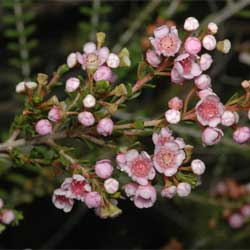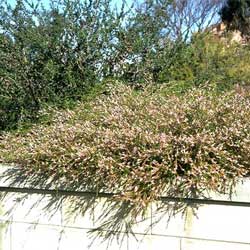Thryptomene saxicola
 |
 |
Rock Thryptomene
Thryptomene saxicola (A.Cunn. ex Hook.) Schauer
Thryptomene saxicola is a member of a purely Australian genus of thirty-five or forty species spread throughout all States of Australia, including Tasmania, although T. saxicola itself is confined to the Stirling and Eyre districts of south-western Western Australia. It grows among granite outcrops in these districts hence its common name Rock Thryptomene.
 Probably
it is the best known of the Australian Thryptomene species, as it was
sold for many years in nurseries as Paynes Thryptomene or Thryptomene 'Paynei'.
These are misnomers and refer only to selected forms of T. saxicola.
Probably
it is the best known of the Australian Thryptomene species, as it was
sold for many years in nurseries as Paynes Thryptomene or Thryptomene 'Paynei'.
These are misnomers and refer only to selected forms of T. saxicola.
The species is usually an erect shrub, 1 m high, but may often have rather pendulous branches. The prolific pink-hued flowers are axillary and are borne along the upper short lateral branches. Leaves are 5-10 mm long and obovate with a characteristic Myrtaceae smell when crushed.
It can be used for cut flowers as severe pruning has no detrimental effect on its vigour or shape. Pruned well, it will generally flowers more profusely in the second year and its potential for cut flowers is excellent.
Like most Thryptomene species, T. saxicola is spring flowering, but carries some flowers most of the year.
Propagation is usually by cuttings as seed has proved to be unreliable. Tip cuttings, taken in spring and placed on a propagation bench with bottom heat, give best results. Hormone rooting powder used before placing the cuttings on the bench greatly enhances the percentage strike. Under these conditions rooting usually takes four to eight weeks. Cuttings taken in spring should be advanced enough for autumn planting.
The site should be well-drained with some frost protection, although only the hardest frost affects this species.
Application of a complete fertilizer in spring and autumn, will be beneficial, especially it the plant is pruned hard for cut flowers. Under these conditions, T. saxicola has proved to be a reliable plant with a marked resistance to the root-rot fungus, Phytophthora cinnamomi.
The Botanic Gardens in Canberra have grown several specimens and no pests or diseases have yet been noted.
Text by ANBG staff, 1977
Name meaning: Thryptomene saxicolaThryptomene from the Greek meaning coy and prudish, the
reason is obscure, perhaps because of its small stature, |
![An Australian Government Initiative [logo]](/images/austgovt_brown_90px.gif)

